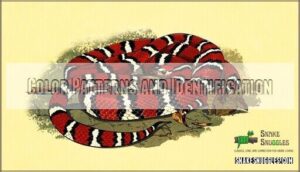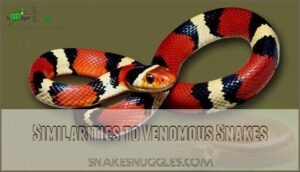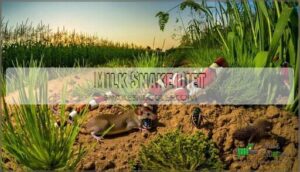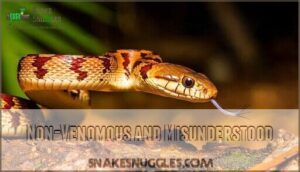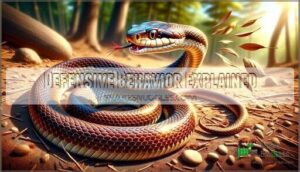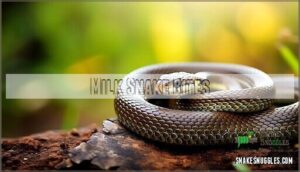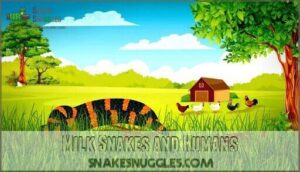This site is supported by our readers. We may earn a commission, at no cost to you, if you purchase through links.
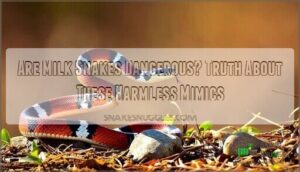
These clever mimics have evolved to look like venomous coral snakes and copperheads as a survival trick, but it’s all for show.
When threatened, they’ll put on quite the performance with tail vibrating and hissing, but they’re basically harmless theatrical performers.
Even if you’re unlucky enough to get bitten, you’ll only deal with minor puncture wounds similar to a cat scratch.
These beneficial serpents actually work as nature’s pest control, keeping rodent populations in check around farms and homes.
Their bite is worse than their bark—wait, that’s backwards.
Table Of Contents
- Key Takeaways
- Milk Snake Description
- Milk Snake Habitat
- Milk Snake Diet
- Are Milk Snakes Dangerous?
- Milk Snake Bites
- Human-Snake Interactions
- Milk Snakes and Humans
- Frequently Asked Questions (FAQs)
- Are milk snakes dangerous?
- Why are milk snakes killed?
- Are milk snakes endangered?
- Are milk snakes aggressive to humans?
- Are milk snakes good to have around?
- What happens if a milk snake bites you?
- Can you pick up milk snakes?
- How poisonous is a milk snake?
- What do baby milk snakes look like?
- Where do milk snakes live in the wild?
- Conclusion
Key Takeaways
- You don’t need to fear milk snakes—they’re completely nonvenomous and harmless to humans, despite their intimidating defensive displays like hissing and tail vibrating.
- You’re actually looking at nature’s pest control specialists when you encounter milk snakes, as they consume rodents that damage crops and spread disease around your property.
- You’ll only experience minor puncture wounds similar to cat scratches if bitten, since milk snakes lack venom glands and pose virtually no medical threat.
- You can distinguish these beneficial mimics from dangerous species by their round pupils, checkerboard belly patterns, and red bands touching black rather than yellow.
Milk Snake Description
You’ll find milk snakes are fascinating nonvenomous reptiles with smooth, glossy scales and slender bodies that often confuse people with their striking resemblance to dangerous species.
These harmless constrictors display remarkable color variations across their 24 subspecies, featuring patterns that can mimic venomous coral snakes or copperheads as a clever survival strategy.
Eastern Milksnake Features
Eastern milksnake characteristics make these reptiles fascinating subjects for wildlife enthusiasts. You’ll recognize them by their distinctive markings and physical traits that separate them from dangerous species.
Key Eastern Features to identify:
- Scale Texture and Snake Patterns: Look for smooth, glossy scales creating a sleek appearance. The eastern milksnake displays red or reddish-brown blotches with black borders against cream, tan, or gray backgrounds.
- Head Shapes and Markings: Notice the narrow, oval-shaped head that’s barely wider than the neck. Most eastern milksnakes sport a characteristic light "Y" or "V-shaped" patch at the head’s base.
- Body Configuration: You’ll spot 3-5 rows of brownish blotches running down their backs, while their bellies show distinctive white and black checkerboard patterns.
Despite their intimidating appearance, milk snake venom doesn’t exist – they’re completely harmless. Understanding these milk snake characteristics helps reduce unnecessary fear about milk snake danger levels when encountering these beneficial constrictors.
Color Patterns and Identification
Identifying milk snakes requires careful attention to their color patterns and visual cues.
These harmless serpents display bold red spots bordered by black bands on cream, white, or yellow backgrounds.
Snake color patterns serve as nature’s identification system – milk snake characteristics include round pupils and checkerboard belly markings that distinguish them from dangerous species.
Pattern recognition becomes trickier as juveniles mature, since their vibrant colors often fade to darker tones.
While coral snake patterns feature similar red and black banding, milk snake identification relies on specific color codes where red touches black rather than yellow, making species identification possible through careful observation.
Similarities to Venomous Snakes
Milk snakes master the art of deception through sophisticated mimicry patterns, fooling both predators and humans into mistaking them for deadly venomous lookalikes. This color mimicry creates frequent snake misidentification scenarios, especially with coral snakes and copperheads.
Key distinguishing features include:
- Round pupils versus vertical slits in venomous species
- Checkerboard belly pattern unique to milk snakes
- Red bands touching black rather than yellow
- Oval-shaped head instead of triangular viper heads
- Smooth scales lacking heat-sensing pits
These defensive behaviors showcase nature’s clever survival strategy. While venomous snake species pose real danger, milk snakes’ harmless nature means their snake danger level remains virtually zero despite their convincing disguise.
Milk Snake Habitat
You’ll discover milk snakes thriving in diverse environments across North and South America, from Canadian forests to Ecuadorian grasslands.
These adaptable reptiles commonly inhabit barns, rocky hillsides, and agricultural areas where they hunt rodents that damage crops and stored grain, making them a beneficial species in agricultural areas.
Preferred Environments
Adaptability defines milk snake habitat preferences across diverse ecosystems.
You’ll find these serpents thriving in Forest Habitats with dense canopy cover, Rocky Terrain offering natural crevices, and Grassland Ecosystems providing abundant prey.
They inhabit Agricultural Land and even Desert Environments, demonstrating remarkable geographic range flexibility.
Understanding milk snake habitat helps appreciate their successful colonization of varied terrains throughout North America.
Their ability to thrive in various environments is also influenced by their captive care requirements that mimic natural conditions.
Agricultural Associations
You’ll find these milk snake habitat champions in agricultural areas and dairy barns, where they’re nature’s farm pest control specialists.
Rather than stealing milk as myths suggest, they hunt rodents that threaten crop protection.
This snake rodent control creates significant agricultural benefits for farmers.
Barn habitats attract milk snakes because rodents seek shelter there.
Their presence supports rural conservation and eco friendly practices by naturally managing pest populations.
Worldwide Habitat Diversity
These remarkably adaptable reptiles showcase nature’s versatility across diverse ecosystems.
You’ll discover milk snakes thriving from Canada’s boreal forests to Ecuador’s tropical rainforests, demonstrating exceptional habitat adaptation that’s made them one of North America’s most widespread serpents.
Their geographic range spans an impressive variety of environments:
- Forest Ecosystems: Deciduous and coniferous woodlands provide ideal cover and abundant prey throughout their North American distribution
- Agricultural Landscapes: Farmlands and grasslands offer excellent rodent hunting grounds while supporting ecosystem services through natural pest control
- Rocky Terrains: Stone outcrops and hillsides create perfect shelter opportunities in both temperate and semi-arid regions
- Wetland Margins: Areas near streams and ponds support diverse prey populations in multiple biodiversity hotspots
This snake’s remarkable distribution success stems from their generalist lifestyle and opportunistic feeding habits.
Whether you’re exploring milk snake habitat in prairie grasslands or mountain forests, their conservation status remains stable thanks to this adaptability.
Their presence across such varied snake habitats demonstrates why they’re considered ecological generalists rather than specialists.
Milk Snake Diet
You’ll find milk snakes are nature’s pest control specialists, hunting rodents that would otherwise damage crops and stored grain.
Their diverse carnivorous diet includes everything from mouse eggs to small mammals, making them valuable allies in agricultural settings.
Natural Pest Control
These beneficial hunters act as natural pest management agents, consuming rodents that damage crops and spread disease.
You’ll appreciate their eco balance services – they target mice, rats, and other agricultural pests without chemicals.
Their wildlife conservation value extends beyond rodent control, as these non venomous snakes help maintain biodiversity preservation in farming communities where natural pest control matters most.
Effective natural pest management involves understanding natural pest solutions to minimize crop damage.
Diverse Diet for Survival
Opportunistic feeders, milk snakes thrive on a remarkably diverse diet that changes with age and season.
Young snakes start with insects and small lizards, while adults shift to primarily hunting mammals and birds.
This adaptive eating strategy helps them survive in various environments and makes them effective at rodent control.
Their hunting tactics include:
- Constriction power – Powerful muscles subdue prey larger than their head width
- Flexible jaws – Specialized ligaments allow swallowing oversized meals
- Nocturnal advantage – Night hunting increases success rates against resting prey
- Opportunistic approach – They’ll eat whatever appropriately-sized food is available
This prey variety spans from mice and bird eggs to amphibians and even other snakes, showcasing remarkable food chain adaptability that defines milk snake behavior and survival success.
Milk snakes exhibit a unique snake feeding behavior that allows them to thrive in different habitats.
Are Milk Snakes Dangerous?
You’ll be relieved to know that milk snakes pose virtually no danger to humans despite their intimidating defensive displays.
These non-venomous serpents rely on bluffing tactics like tail vibrating and hissing to avoid confrontation, but they’re far more interested in escaping than engaging with people.
Non-Venomous and Misunderstood
Understanding milk snake behavior dispels common Milk Snake Myths and supports Snake Conservation efforts.
You’ll find these nonvenomous snakes are completely harmless despite their intimidating appearance.
Reptile Research confirms they’re nonpoisonous and beneficial for pest control.
Learning about snake venom facts helps clarify the differences between venomous and non-venomous species.
| Myth | Reality | Conservation Impact |
|---|---|---|
| Venomous bite | milk snake bite is harmless | Reduces unnecessary killing |
| Drinks cow milk | Hunts rodents in barns | Promotes Wildlife Protection |
| Aggressive nature | Docile milk snake behavior | Supports Species Preservation |
Following proper snake safety tips protects both you and these valuable reptiles from misunderstandings.
Defensive Behavior Explained
Milk snakes employ several defensive mechanisms when threatened, though they prefer escape tactics over confrontation.
When cornered, these harmless serpents transform into convincing mimics of dangerous species.
Their primary defensive behaviors include:
- Tail vibration against dry leaves, creating rattlesnake-like sounds
- Body flattening and loud hissing to appear larger and more intimidating
- Rapid fleeing to nearby cover like logs, rocks, or dense vegetation.
Snake posturing occurs when escape routes are blocked.
Their threat response involves coiling and striking only as a last resort.
These defensive mechanisms rarely result in actual bites, as milk snakes prioritize self-preservation over aggression.
Understanding these snake safety tips helps distinguish normal defensive behaviors from genuine danger signs, reducing unnecessary fear during wildlife encounters.
Milk Snake Bites
You’ll find that milk snake bites cause only minor puncture wounds since these non-venomous reptiles lack toxin-delivering fangs.
While their defensive bite might startle you, the small teeth create superficial scratches that heal quickly with basic first aid care, and it’s worth noting the overall effect is relatively minor.
Consequences and Symptoms
Most milk snake bite reactions are surprisingly mild—these encounters rarely break the skin and feel more like a pinch than a snake attack.
When bites do occur, expect minimal redness and slight swelling, nothing like the dramatic snake attack symptoms you’d see from venomous snakes characteristics.
The venom myth surrounding milk snakes causes unnecessary panic since they lack venom glands entirely. Unlike true snake venom effects, you won’t experience paralysis, muscle aches, or systemic symptoms.
Allergic responses are exceptionally rare and poorly documented. Most people worry about snake danger signs that simply don’t apply here.
The main concern involves preventing infection through proper wound cleaning, as snake mouths carry bacteria from their rodent prey. Medical treatment typically isn’t necessary unless secondary infection develops.
First Aid and Treatment
Despite milk snakes being non-venomous, proper wound care remains essential after any snake bite.
Here’s your emergency response checklist:
Immediate Actions:
- Call emergency services immediately
- Photograph the snake from a safe distance
- Move victim away from snake’s striking range
- Keep victim calm and still
- Position bite at or below heart level
- Remove tight jewelry before swelling begins
- Clean wound gently with soap and water
- Apply loose, sterile bandage
- Monitor breathing and pulse
- Document bite time and circumstances
- Stay with victim until help arrives
- Keep emergency contacts handy
Critical Don’ts:
- Don’t attempt venom removal by mouth
- Don’t apply ice or heat
- Don’t use tourniquets
- Don’t cut the wound
- Don’t give alcohol or medications
- Don’t wait for snake bite treatment
- Don’t handle the snake
- Don’t panic or rush unnecessarily
- Don’t apply electrical shock
- Don’t assume it’s harmless
- Don’t delay medical treatment
- Don’t ignore snake attack symptoms
It’s vital to understand snake bite first aid procedures to guarantee effective treatment and minimize risks.
Human-Snake Interactions
Understanding how to safely interact with milk snakes protects both you and these beneficial reptiles.
You’ll discover the truth behind common myths while learning proper wildlife observation techniques that guarantee positive encounters for everyone involved, which includes learning about positive encounters.
Ethical Wildlife Viewing
Encountering milk snakes in the wild offers incredible opportunities for responsible viewing and wildlife respect. You’ll want to maintain proper animal distance—at least six feet—when observing these harmless species.
Remember, they’re naturally shy and prefer escape over confrontation. Your best observation tips include moving slowly and keeping noise to a minimum.
These snakes detect vibrations through the ground, so heavy footsteps will send them slithering away before you can appreciate their beautiful banding patterns. Use binoculars or a camera’s zoom function for close-up viewing without disturbing their natural behavior.
For ideal viewing, consider using high-quality optical viewing tools to enhance your experience. Snake viewing becomes rewarding eco tourism when you follow ethical guidelines.
Never attempt to handle wild milk snakes, even though they’re non-venomous. This causes unnecessary stress and can trigger defensive responses like tail vibrating or musk release.
Proper snake safety means respecting their space while enjoying the educational experience. You’re witnessing nature’s pest control specialist at work—milk snakes consume countless rodents that would otherwise damage crops and spread disease.
This snake wildlife viewing opportunity helps you understand their ecological importance firsthand, and by doing so, you are supporting responsible wildlife viewing practices.
Dispelling Myths and Education
Why do so many people fear milk snakes when they’re completely harmless?
Persistent snake myths fuel unnecessary killing of these beneficial reptiles. The dairy-drinking legend lacks any scientific basis—milk snakes hunt barn rodents, not cow milk.
Educational programs effectively combat snake misconceptions, with hands-on experiences reducing fear fourfold.
Understanding milk snake facts through wildlife education and conservation efforts promotes coexistence and protects these valuable pest controllers.
Milk Snakes and Humans
When you encounter a milk snake in your yard or barn, you’re meeting one of nature’s most beneficial pest controllers that poses no threat to humans.
These harmless constrictors actually help protect your property by keeping rodent populations in check, making them valuable allies rather than dangerous enemies.
Snake Handling and Respect
Understanding proper snake etiquette starts with maintaining a respectful distance when you encounter milk snakes in the wild.
These nonvenomous creatures pose no real threat, but they don’t know you’re friendly.
Wildlife awareness means recognizing that even harmless snakes will use snake defense mechanisms like tail vibrating and musking when stressed.
Safe handling requires patience and preparation.
If you’re keeping milk snakes as pets, limit interactions to 2-3 times weekly for short sessions.
Always support their entire body—never grab the head or tail.
Skip handling during shedding periods or after feeding to prevent stress responses.
Gentle interaction begins with proper hygiene.
Wash your hands before and after contact, as reptiles can carry Salmonella.
Clean enclosures weekly with diluted bleach solution.
Watch for stress signals like hiding or defensive posturing, and respect their boundaries.
Choose captive-bred individuals over wild-caught specimens.
This approach supports snake bite prevention and guarantees healthier pets while protecting wild populations.
For professional snake handling, investing in proper snake handling kits is essential to minimize risks.
Eco-Services and Coexistence
Beyond respectful handling practices, you’ll find that milk snakes offer remarkable ecosystem balance through their natural services. These nonvenomous constrictors act as living pest control systems, consuming rodents that damage crops and spread disease.
Conservation efforts for wildlife preservation focus on three key areas:
- Educational programs that teach snake bite prevention through proper identification of snake defense mechanisms
- Habitat protection initiatives supporting species coexistence in agricultural zones
- Community outreach promoting environmental sustainability through milk snake care awareness
When you encounter milk snakes near barns or gardens, they’re actually working for you. A single adult can eliminate dozens of mice annually, protecting stored grain and reducing property damage. Unfortunately, mistaken identity leads to unnecessary killings—many people can’t distinguish harmless mimics from venomous species.
Snake handling safety starts with education. Learning to identify milk snakes’ round pupils, checkerboard belly patterns, and defensive tail-vibrating behaviors helps you appreciate these beneficial neighbors rather than fear them. Understanding their role in milk snake habitat is essential for coexisting with these animals.
Frequently Asked Questions (FAQs)
Are milk snakes dangerous?
Zero confirmed attacks on humans exist in medical records.
Milk snakes aren’t dangerous—they’re completely nonvenomous constrictors that mimic dangerous species for protection.
You’re safer around them than most household pets.
Why are milk snakes killed?
Milk snakes get killed because people mistake them for venomous copperheads or coral snakes.
Their red, black, and yellow bands create confusion, triggering fear-based reactions that lead to unnecessary killings despite their harmless nature.
Are milk snakes endangered?
Currently, most subspecies aren’t endangered, though habitat destruction threatens some populations. You’ll find milk snakes face pressure from urbanization and mistaken killings, but they’re generally stable across their range.
Are milk snakes aggressive to humans?
No, milk snakes aren’t aggressive toward humans. They’re naturally docile and prefer escaping when threatened. You’ll rarely see them strike unless cornered, and they become tame with gentle handling.
Are milk snakes good to have around?
Yes, you’ll want milk snakes around your property! These beneficial reptiles control rodent populations naturally, eating mice and rats that damage crops and spread disease, making them valuable pest controllers.
What happens if a milk snake bites you?
If you’re bitten by a milk snake, expect minor puncture wounds and possible bleeding.
These nonvenomous snakes can’t inject toxins, so you’ll only need basic wound care and monitoring for infection.
Can you pick up milk snakes?
Like handling a garden hose, you can pick up milk snakes, but they’ll likely squirm and may bite defensively.
They’re non-venomous, so bites cause minor puncture wounds.
Wild snakes stress easily, so it’s better to observe from a distance.
How poisonous is a milk snake?
Milk snakes aren’t poisonous at all—they’re completely harmless to humans. You’d have to eat one to experience poisoning, which isn’t recommended! They’re nonvenomous constrictors that pose zero toxic threat.
What do baby milk snakes look like?
Baby milk snakes measure 6-12 inches at hatching, displaying the same colorful banded patterns as adults but more vibrant.
You’ll notice their distinct red, black, and white rings immediately after they emerge from eggs.
Where do milk snakes live in the wild?
Where exactly do these fascinating serpents call home?
You’ll find milk snakes throughout North and South America, from southern Canada to Ecuador.
They’re incredibly adaptable, thriving in forests, grasslands, rocky hillsides, and agricultural areas like barns where they hunt rodents.
Conclusion
Despite appearing in over 90% of snake-bite fear surveys, are milk snakes dangerous remains one of nature’s biggest misconceptions.
These remarkable mimics aren’t dangerous at all—they’re completely nonvenomous constrictors that benefit your property by controlling rodent populations.
You’ll encounter defensive displays like hissing and tail vibrating, but it’s pure theater from these harmless serpents.
If bitten, you’ll experience only minor puncture wounds requiring basic first aid, and understanding their peaceful nature transforms fear into appreciation for these beneficial backyard allies.
- https://a-z-animals.com/blog/are-milk-snakes-poisonous-or-dangerous/
- https://www.livescience.com/53333-milk-snakes.html
- https://www.webmd.com/pets/what-to-know-about-the-honduran-milk-snake
- https://www.battlbox.com/blogs/outdoors/can-milk-snakes-bite-understanding-the-myths-and-facts
- https://portal.ct.gov/-/media/DEEP/wildlife/pdf_files/outreach/fact_sheets/milksnakepdf.pdf


